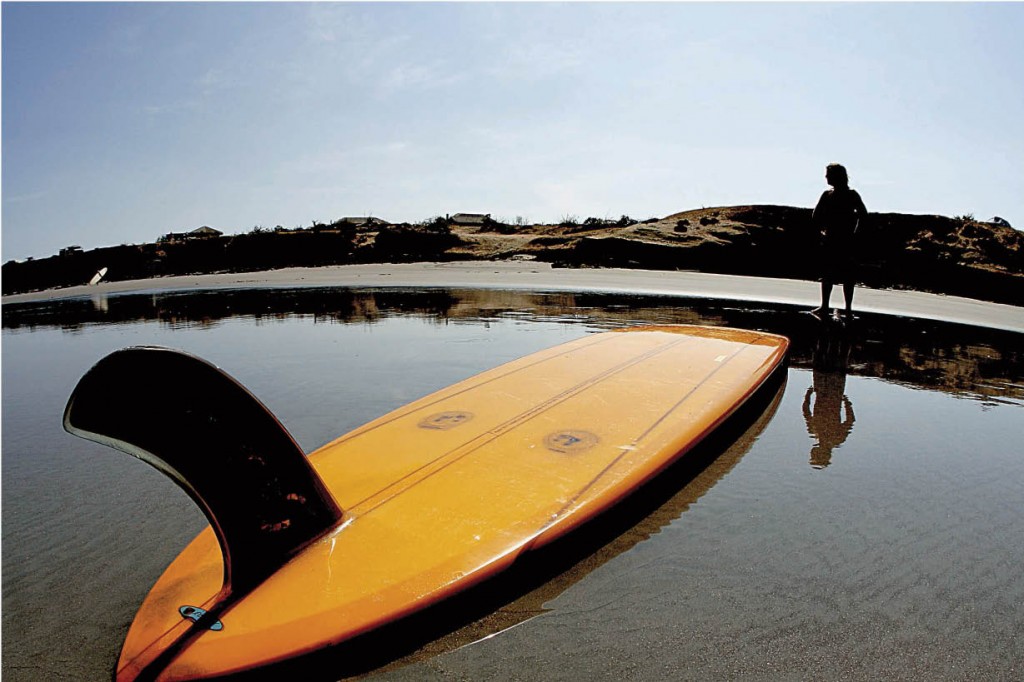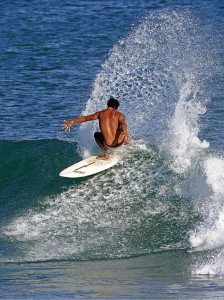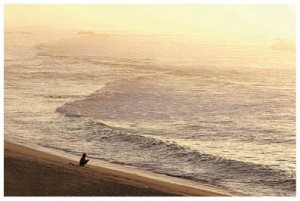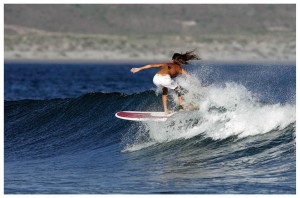 by Bryan Jáuregui & Mario Becerril, photos by Jocelyn Mathe
by Bryan Jáuregui & Mario Becerril, photos by Jocelyn Mathe
In the age of jet-setting surfers pursuing monster waves across the globe for fame and money; of California surf breaks so crowded it is not uncommon to see 100 boards or more in the water; of jet skis towing surfers to catch waves that the human body could never conquer on its own, it is wonderful to hear Todos Santos resident Steve Merrill recall the age in which he first saw a surfer. “It was 1956 and I was six years old. My parents were driving the car along Pleasure Point in Santa Cruz, California, and I saw a guy standing on a giant wooden board gliding across the waves, completely alone on the water. It is impossible to describe the impact that vision had on me. I knew then and there that surfing was what I had to do.” Steve’s immediate enthrallment with surfing is echoed in the voice of the young narrator in Australian writer Tim Winton’s surfer-coming-of-age novel Breath, “How strange it was to see men do something beautiful. Something pointless and elegant, as though nobody saw or cared…as if dancing on water was the best and bravest thing a man could do.” Back in the day, Winton tells us, surfing was the closest a man could get to poetry.
If surfing is akin to poetry then Todos Santos today is the City Lights Bookstore and the Beatniks are having a poetry slam. “We’re living the bonus years here in Todos Santos,” says surfing resident Billy Girvan. Like many expats in the Todos Santos surfing community, Billy grew up in California just as surfing culture was taking root. “In 1959 I was 12 years old and saw these guys surfing in Santa Barbara. All I wanted was to be like them. It wasn’t just the surfing; it was the life style that was so appealing, the beach life, the freedom. They were so different from everyone else. I traded my go-cart for a surfboard and never looked back.” Todos Santos surfer Jim McRoberts knows just how he feels. “In 1962 I was 15 and living in Sierra Madre, California. My uncle was a founding member of the San Onofre Surf Cub and took me with him to the beach one day. That first time riding a wave, the sensation was simply amazing. It took hold of me immediately and I couldn’t think of doing anything else. My passion has never lessened from that day to this.” Like Billy, Jim was just as in love with the surfing culture as with the surfing itself. “Everything important was happening at the beach.”
Billy, Jim, Steve and countless other expat surfers living in Todos Santos went from being “grommets,” or “gremmies”—slang for young surfers—to embracing the full surfing life as older teens and adults. A lot of school was missed, a lot of pretty girls chased, a lot non-food items ingested and a whole lot of waves caught. Poetry? Absolutely. “Poetry is not only dream and vision,” says poet Audre Lorde, “It is the skeleton architecture of our lives. It [is] a bridge across our fears of what has never been before.” For these boys surfing was the bridge to embracing nature in a most intimate, thrilling and terrifying way. Surfing was the bridge out of an ordinary life into something sublime. Surfing was the bridge to salvation. “Going to the ocean is like going to church for me,” says Jim who went on to get a Masters in English and is currently writing a novel about surfing. “If it wasn’t for surfing I would have been a drug addict or alcoholic like a lot of my friends. You have to stay physically fit to surf. It saved me.” Billy, who went on to become a founding member and bass player for the hard rock band NoXit, agrees. “I was in the midst of living this rock star’s life and surfing is definitely what kept me healthy, what kept me alive.”
 As countless movies and songs throughout the 1960’s and ‘70s glamorized surfing culture, the surf breaks in California inevitably became more crowded and surfers became more territorial and protective of their breaks, often resulting in a tense and aggressive atmosphere. Some surfers, like Steve Meisenger, or “Meisy,” started looking elsewhere and in 1973 at the age of 18 the Morro Bay, California board shaper started coming to Baja to enjoy the peninsula’s stark beauty and uncrowded breaks. “I was getting a degree in Ornamental Horticulture at Cal Poly and would save all the money I made shaping boards during the year to come to Baja in the summer. We would live in the van and camp on the beach. We never went out to eat; we never stayed in a hotel. All of our money went to surfing and survival.” Meisy started a successful, 30-year career as a housing contractor but continued to come to Baja at least once a year. He stumbled upon Todos Santos in 1981 while looking for a mechanic. He was captivated. He found himself returning to surf the breaks here every year, and by 1990 had bought property and started building his house. “The environment in most of Baja is so harsh, but in Todos Santos we get the great waves as well as this lush environment, great weather and wonderful creature comforts.”
As countless movies and songs throughout the 1960’s and ‘70s glamorized surfing culture, the surf breaks in California inevitably became more crowded and surfers became more territorial and protective of their breaks, often resulting in a tense and aggressive atmosphere. Some surfers, like Steve Meisenger, or “Meisy,” started looking elsewhere and in 1973 at the age of 18 the Morro Bay, California board shaper started coming to Baja to enjoy the peninsula’s stark beauty and uncrowded breaks. “I was getting a degree in Ornamental Horticulture at Cal Poly and would save all the money I made shaping boards during the year to come to Baja in the summer. We would live in the van and camp on the beach. We never went out to eat; we never stayed in a hotel. All of our money went to surfing and survival.” Meisy started a successful, 30-year career as a housing contractor but continued to come to Baja at least once a year. He stumbled upon Todos Santos in 1981 while looking for a mechanic. He was captivated. He found himself returning to surf the breaks here every year, and by 1990 had bought property and started building his house. “The environment in most of Baja is so harsh, but in Todos Santos we get the great waves as well as this lush environment, great weather and wonderful creature comforts.”
 The magic of Todos Santos surfing has a powerful pull. By the time Billy first visited Todos Santos in 1994 it had been 14 years since he’d last been on a surf board. But much to his joy he found that he could still ride the waves. Much to the consternation of his wife he also found that he really wanted to surf all the time, once again. “But luckily that beautiful woman really loves me so when I said I wanted to move to Todos Santos to surf she backed me 100%. We sold all of our property and here we are.” Jim knows just what he means. When he and his wife married in 1989 they moved to the mountains of Oregon so they could pursue her love of horses. “But I thought about surfing every single day and even carved a sculpture of a wave to put over the mantel.” A 3-year road trip throughout the North American continent brought them to Todos Santos in 2009. It had been 20 years since Jim was last on a surf board, but the magic returned immediately. “Every good wave that you ride is like a gift. It is this energy that is there for you personally, energy that has come 2,000 miles for you to merge with and take to the Todos Santos shore.” Jim and his wife sold their Oregon property and have been in Todos Santos ever since.
The magic of Todos Santos surfing has a powerful pull. By the time Billy first visited Todos Santos in 1994 it had been 14 years since he’d last been on a surf board. But much to his joy he found that he could still ride the waves. Much to the consternation of his wife he also found that he really wanted to surf all the time, once again. “But luckily that beautiful woman really loves me so when I said I wanted to move to Todos Santos to surf she backed me 100%. We sold all of our property and here we are.” Jim knows just what he means. When he and his wife married in 1989 they moved to the mountains of Oregon so they could pursue her love of horses. “But I thought about surfing every single day and even carved a sculpture of a wave to put over the mantel.” A 3-year road trip throughout the North American continent brought them to Todos Santos in 2009. It had been 20 years since Jim was last on a surf board, but the magic returned immediately. “Every good wave that you ride is like a gift. It is this energy that is there for you personally, energy that has come 2,000 miles for you to merge with and take to the Todos Santos shore.” Jim and his wife sold their Oregon property and have been in Todos Santos ever since.
No matter whether they surfed every day for the past 5 decades or abandoned the waves for years, surfing still provides the “skeleton architecture” of these men’s lives as they move through their 60s. One of the key reasons they love surfing Todos Santos is, as Steve says, “This is as nice a surfing community as anyone could ever hope to find. There is hardly any localism and everyone on the waves is respectful and supportive of each other in the water.” While they may not have the stamina and moves of youth, the men don’t seem to mind (much). “Let’s face it;” says Billy, “the best surfer out there is the one having the most fun. And that’s usually me!” Coming from a guy with 2 titanium bars, 4 screws and 3 vertical spacers holding his back together, that’s no mean feat. Billy already has days on the water when his back prevents him from getting up on the board, and he can see a time coming when he won’t be physically able to surf any more. “But I’m just not that worried,” says Billy. “There is always mind surfing!” Poetry? Oh yes indeed.
—
Surfari! Baja Surf Camp for Women
 National Geographic lists Surfing in Todos Santos as one of its Best Adventure Destinations for 2012, so it’s safe to say that the word is out about Todos Santos as a surfing hotspot. But there is still a desire among the local surfing community to protect the identity of the more challenging breaks, so if you’re an experienced surfer and want to suss these out, you’ll just have to hang around town a bit and buy the locals a few beers. But for those of you who are new to surfing or still relatively inexperienced on the waves, there is no place in the world like Los Cerritos Beach. With a smooth sandy bottom, clean, unpolluted waters and a wave dynamic that always creates a safe spot for beginners to practice, it’s no wonder that surfing entrepreneur Mario Bercerril chose it for his “office,” the place where he developed MIST, Mario’s Infallible Surfing Technique.
National Geographic lists Surfing in Todos Santos as one of its Best Adventure Destinations for 2012, so it’s safe to say that the word is out about Todos Santos as a surfing hotspot. But there is still a desire among the local surfing community to protect the identity of the more challenging breaks, so if you’re an experienced surfer and want to suss these out, you’ll just have to hang around town a bit and buy the locals a few beers. But for those of you who are new to surfing or still relatively inexperienced on the waves, there is no place in the world like Los Cerritos Beach. With a smooth sandy bottom, clean, unpolluted waters and a wave dynamic that always creates a safe spot for beginners to practice, it’s no wonder that surfing entrepreneur Mario Bercerril chose it for his “office,” the place where he developed MIST, Mario’s Infallible Surfing Technique.
“I developed this technique over many years of teaching, and there are essentially two approaches. There is the 3-step technique for people with better balance and strength, and the 4-step technique for those who need a little more work in these areas. But no matter which option works for them, all my students get up in the first lesson—and have a great time doing it!” Mario is serious about this. If you don’t get up on the board in your first surf lesson he’ll give you your money back!
Mario and Todos Santos Eco Adventures have teamed up to create the perfect surfing all-girl getaway: Surfari! Baja Surf Camp for Women. Featured on the Travel Channel and gaining rapidly in popularity, the Baja Surf Camp for Women features yoga classes and surf lessons each morning, a fun/indulgent activity each afternoon, and a fabulous Todos Santos dining experience each evening. Horseback riding, cooking classes, swimming with sea lions and not one but two massages are all part of this fabulous week that features pampering and adventuring in equal doses.
Bryan Jáuregui and her husband Sergio are the owners/operators of Todos Santos Eco Adventures and Mario Becerril is the owner/operator of Mario’s Surf School. Together they operate Surfari! Baja Surf Camp for Women. For more information please visit
www.tosea.net and www.mariosurfschool.com
Related stories:
Mario’s Guide to Surfing the Cape
Women Surfers
Local Surfer: Dany Torres
Jocelyn Mathe – Surf Photographer

